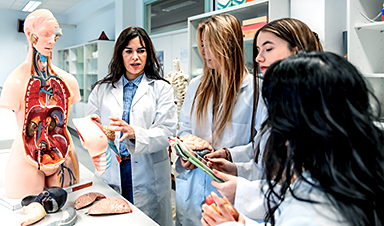For decades, a substantial number of proteins, vital for treating various diseases, have remained elusive to oral drug therapy. Traditional small molecules often struggle to bind to proteins with flat surfaces or require specificity for particular protein homologs. Typically, larger biologics that can target these proteins demand injection, limiting patient convenience and accessibility.
“There are many diseases for which the targets were identified but drugs binding and reaching them could not be developed,” says Heinis. “Most of them are types of cancer, and many targets in these cancers are protein-protein interactions that are important for the tumor growth but cannot be inhibited.”
The study focused on cyclic peptides, which are versatile molecules known for their high affinity and specificity in binding challenging disease targets. At the same time, developing cyclic peptides as oral drugs has proven difficult because they are rapidly digested or poorly absorbed by the gastrointestinal tract.
“Cyclic peptides are of great interest for drug development as these molecules can bind to difficult targets for which it has been challenging to generate drugs using established methods,” says Heinis. “But the cyclic peptides cannot usually be administered orally—as a pill—which limits their application enormously.”
Cyclizing breakthrough
The research team targeted the enzyme thrombin, which is a critical disease target because of its central role in blood coagulation; regulating thrombin is key to preventing and treating thrombotic disorders like strokes and heart attacks.
To generate cyclic peptides that can target thrombin and are sufficiently stable, the scientists developed a two-step combinatorial synthesis strategy to synthesize a vast library of cyclical peptides with thioether bonds, which enhance their metabolic stability when taken orally.
“We have now succeeded in generating cyclic peptides that bind to a disease target of our choice and can also be administered orally,” says Heinis. “To this end, we have developed a new method in which thousands of small cyclic peptides with random sequences are chemically synthesized on a nanoscale and examined in a high-throughput process.”
Two steps, one pot
The new method process involves two steps, and takes place in the same reactive container, a feature that chemists refer to as “one pot.”
The first step is to synthesize linear peptides, which then undergo a chemical process of forming a ring-like structure—in technical terms, being “cyclized.” This is done with using “bis-electrophilic linkers”—chemical compounds used to connect two molecular groups together—to form stable thioether bonds.
In the second phase, the cyclized peptides undergo acylation, a process that attaches carboxylic acids to them, further diversifying their molecular structure.
The technique eliminates the need for intermediate purification steps, allowing for high-throughput screening directly in the synthesis plates, combining the synthesis and screening of thousands of peptides to identify candidates with high affinity for specific disease targets—in this case, thrombin.
Using the method, the Ph.D. student leading the project, Manuel Merz, was able to generate a comprehensive library of 8,448 cyclic peptides with an average molecular mass of about 650 Daltons (Da), only slightly above the maximum limit of 500 Da recommended for orally-available small molecules.
The cyclic peptides also showed a high affinity for thrombin.
When tested on rats, the peptides showed oral bioavailability up to 18%, which means that when the cyclic peptide drug is taken orally, 18% of it successfully enters the bloodstream, and to have a therapeutic effect. Considering that orally-administered cyclic peptides generally show a bioavailability below 2%, increasing that number to 18% is a substantial advance for drugs in the biologics category—which includes peptides.
Setting targets
By enabling the oral availability of cyclic peptides, the team has opened up possibilities for treating a range of diseases that have been challenging to address with conventional oral drugs. The method’s versatility means it can be adapted to target a wide array of proteins, potentially leading to breakthroughs in areas where medical needs are currently unmet.
“To apply the method to more challenging disease targets, such as protein-protein interactions, larger libraries will likely need to be synthesized and studied,” says Manuel Merz. “By automating further steps of the methods, libraries with more than one million molecules seem to be within reach.”
In the next step of this project, the researchers will target several intracellular protein-protein interaction targets for which it has been difficult to develop inhibitors based on classical small molecules. They are confident that orally applicable cyclic peptides can be developed for at least some of them.
More information: Alexander L. Nielsen, De novo development of small cyclic peptides that are orally bioavailable, Nature Chemical Biology (2023). DOI: 10.1038/s41589-023-01496-y
Journal information: Nature Chemical Biology
News
Repurposed drugs could calm the immune system’s response to nanomedicine
An international study led by researchers at the University of Colorado Anschutz Medical Campus has identified a promising strategy to enhance the safety of nanomedicines, advanced therapies often used in cancer and vaccine treatments, [...]
Nano-Enhanced Hydrogel Strategies for Cartilage Repair
A recent article in Engineering describes the development of a protein-based nanocomposite hydrogel designed to deliver two therapeutic agents—dexamethasone (Dex) and kartogenin (KGN)—to support cartilage repair. The hydrogel is engineered to modulate immune responses and promote [...]
New Cancer Drug Blocks Tumors Without Debilitating Side Effects
A new drug targets RAS-PI3Kα pathways without harmful side effects. It was developed using high-performance computing and AI. A new cancer drug candidate, developed through a collaboration between Lawrence Livermore National Laboratory (LLNL), BridgeBio Oncology [...]
Scientists Are Pretty Close to Replicating the First Thing That Ever Lived
For 400 million years, a leading hypothesis claims, Earth was an “RNA World,” meaning that life must’ve first replicated from RNA before the arrival of proteins and DNA. Unfortunately, scientists have failed to find [...]
Why ‘Peniaphobia’ Is Exploding Among Young People (And Why We Should Be Concerned)
An insidious illness is taking hold among a growing proportion of young people. Little known to the general public, peniaphobia—the fear of becoming poor—is gaining ground among teens and young adults. Discover the causes [...]
Team finds flawed data in recent study relevant to coronavirus antiviral development
The COVID pandemic illustrated how urgently we need antiviral medications capable of treating coronavirus infections. To aid this effort, researchers quickly homed in on part of SARS-CoV-2's molecular structure known as the NiRAN domain—an [...]
Drug-Coated Neural Implants Reduce Immune Rejection
Summary: A new study shows that coating neural prosthetic implants with the anti-inflammatory drug dexamethasone helps reduce the body’s immune response and scar tissue formation. This strategy enhances the long-term performance and stability of electrodes [...]
Scientists discover cancer-fighting bacteria that ‘soak up’ forever chemicals in the body
A family of healthy bacteria may help 'soak up' toxic forever chemicals in the body, warding off their cancerous effects. Forever chemicals, also known as PFAS (per- and polyfluoroalkyl substances), are toxic chemicals that [...]
Johns Hopkins Researchers Uncover a New Way To Kill Cancer Cells
A new study reveals that blocking ribosomal RNA production rewires cancer cell behavior and could help treat genetically unstable tumors. Researchers at the Johns Hopkins Kimmel Cancer Center and the Department of Radiation Oncology and Molecular [...]
AI matches doctors in mapping lung tumors for radiation therapy
In radiation therapy, precision can save lives. Oncologists must carefully map the size and location of a tumor before delivering high-dose radiation to destroy cancer cells while sparing healthy tissue. But this process, called [...]
Scientists Finally “See” Key Protein That Controls Inflammation
Researchers used advanced microscopy to uncover important protein structures. For the first time, two important protein structures in the human body are being visualized, thanks in part to cutting-edge technology at the University of [...]
AI tool detects 9 types of dementia from a single brain scan
Mayo Clinic researchers have developed a new artificial intelligence (AI) tool that helps clinicians identify brain activity patterns linked to nine types of dementia, including Alzheimer's disease, using a single, widely available scan—a transformative [...]
Is plastic packaging putting more than just food on your plate?
New research reveals that common food packaging and utensils can shed microscopic plastics into our food, prompting urgent calls for stricter testing and updated regulations to protect public health. Beyond microplastics: The analysis intentionally [...]
Aging Spreads Through the Bloodstream
Summary: New research reveals that aging isn’t just a local cellular process—it can spread throughout the body via the bloodstream. A redox-sensitive protein called ReHMGB1, secreted by senescent cells, was found to trigger aging features [...]
AI and nanomedicine find rare biomarkers for prostrate cancer and atherosclerosis
Imagine a stadium packed with 75,000 fans, all wearing green and white jerseys—except one person in a solid green shirt. Finding that person would be tough. That's how hard it is for scientists to [...]
Are Pesticides Breeding the Next Pandemic? Experts Warn of Fungal Superbugs
Fungicides used in agriculture have been linked to an increase in resistance to antifungal drugs in both humans and animals. Fungal infections are on the rise, and two UC Davis infectious disease experts, Dr. George Thompson [...]





















